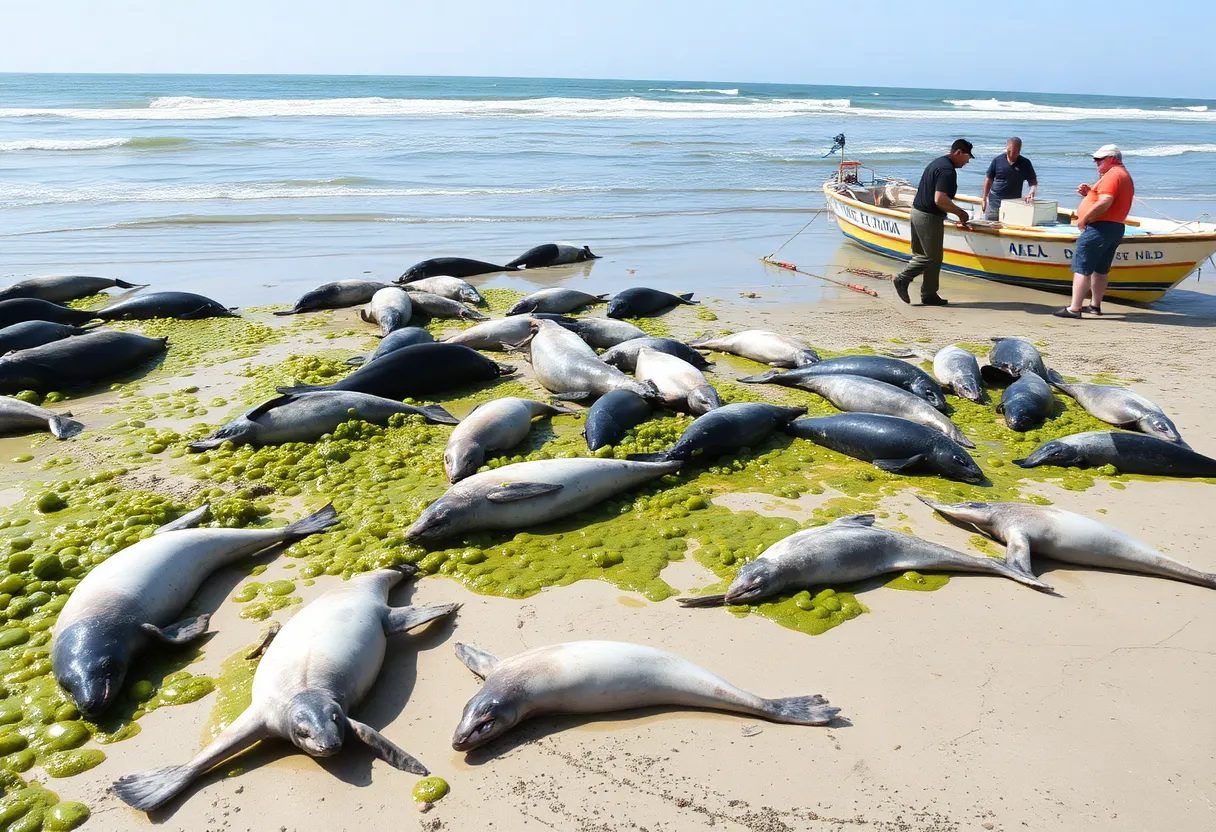News Summary
Ventura County is facing a severe environmental crisis due to an unprecedented harmful algal bloom. This situation has resulted in increased marine mammal deaths, including whales, dolphins, and sea lions. Experts are conducting necropsies to investigate the high levels of domoic acid, a toxic substance that threatens marine life. Nonprofit organizations are striving to rescue ill animals amidst this growing crisis, while researchers hope for the recovery of marine populations if adequate support is provided.
Unprecedented Algal Bloom Impacts Marine Life in Ventura County
Ventura County has recently become the unfortunate center of a serious environmental crisis. An unprecedented bloom of harmful algae has led to a heartbreaking surge in marine mammal deaths along the Southern California coast. Reports are pouring in as more dead marine creatures wash ashore, raising concerns among local communities and environmental organizations.
What’s Happening Off the Coast?
Sky5 aerial footage revealed a distressing scene along the coastline near the Ventura Fairgrounds. Among the casualties, a deceased whale, a dead dolphin, and a disoriented sea lion were all spotted, emphasizing the dire situation at hand. Experts are conducting necropsies—basically animal autopsies—to investigate whether these unfortunate animals were affected by dangerously high levels of domoic acid, a known neurotoxin that profoundly impacts the brain and nervous system of marine animals.
The Ripple Effect on Marine Life
This toxic algae bloom doesn’t just threaten individual animals; it disrupts the whole marine food chain. In recent months, the consequences have led to the illness or death of thousands of animals. Nonprofit organizations dedicated to marine rescue, such as the Pacific Marine Mammal Center and the Channel Islands Marine and Wildlife Institute, have stepped in to help. They are working tirelessly to rescue sick animals, though the situation is far from straightforward.
For sea lions, rehabilitation is sometimes successful, but rescuing dolphins poses its own set of challenges. By the time a dolphin is found stranded on the beach, it’s often too late for effective treatment. The volume of calls coming into rescue organizations has surged since February, particularly regarding ill sea lions, marking this bloom as one of the largest in recent memory.
Heartbreaking Discoveries and Findings
Signs of domoic acid poisoning in marine mammals include disorientation, seizures, and aggressive behaviors, alarming signals that these creatures are in distress. Authorities emphasize the importance of public safety and advise against approaching or disturbing any stranded animals. Instead, they encourage people to report sick marine mammals through official channels.
Expanding Crisis
Hope for the Future?
Despite the grim situation, some researchers hold onto hope. There is a belief in the resilience and potential recovery of marine mammal populations if they receive adequate resources and support. As local communities rally around this issue, awareness is rising, and the hope is that concerted efforts can slowly turn the tide for these majestic creatures.
In conclusion, the ongoing environmental challenges in Ventura County serve as a wake-up call for all of us. It’s a reminder of the delicate balance nature maintains and how our actions impact it. Staying informed and engaging in community efforts remains crucial as we navigate this difficult time for our marine friends.
Deeper Dive: News & Info About This Topic
- KTLA: More Dead Whales Wash Ashore in Ventura County
- Wikipedia: Domoic Acid
- KEYT: Marine Animals Wash Up Dead in Ventura County
- Google Search: Toxic Algae Bloom Southern California
- VC Star: Dead Whale Washes Up on Ventura Beach
- Encyclopedia Britannica: Marine Biology
- ABC News: Toxic Algae Bloom Killing Marine Life in Southern California
- Google News: Marine Mammal Deaths

Author: STAFF HERE HOLLYWOOD
The Hollywood Staff Writer represents the experienced team at HEREHollywood.com, your go-to source for actionable local news and information in Hollywood, Los Angeles County, and beyond. Specializing in "news you can use," we cover essential topics like product reviews for personal and business needs, local business directories, politics, real estate trends, neighborhood insights, and state news affecting the area—with deep expertise drawn from years of dedicated reporting and strong community input, including local press releases and business updates. We deliver top reporting on high-value events such as the Hollywood Bowl summer concerts, the Hollywood Christmas Parade, film premieres at TCL Chinese Theatre, and festivals at the Magic Castle. Our coverage extends to key organizations like the Hollywood Chamber of Commerce and Visit Hollywood, plus leading businesses in entertainment, dining, and tourism that define the local economy. As part of the broader HERE network, including HERELosAngeles.com, HEREBeverlyHills.com, HEREAnaheim.com, and HEREHuntingtonBeach.com, we provide comprehensive, credible insights into Southern California's dynamic landscape.





